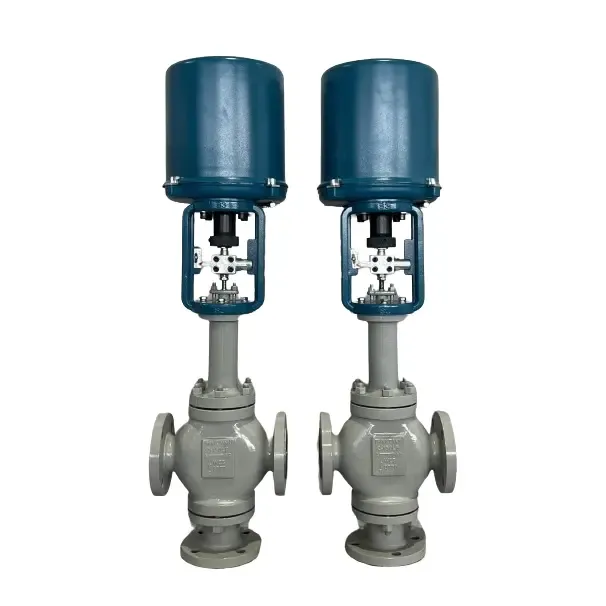
In industrial fluid control systems, the ability to manage and direct the flow of media—whether it’s water, oil, air, or gases—is critical for ensuring efficient and safe operations. Two key types of valves that play a pivotal role in these systems are mixing control valves and diverting control valves. While both are designed to regulate flow, they serve distinct purposes and are used in different applications. This article delves into the definitions, functions, and differences between mixing and diverting control valves, providing a comprehensive understanding of their roles in fluid control systems.
A mixing control valve is designed to combine two separate flow streams into a single output. It features two input ports and one output port, with a plug or actuator that adjusts the proportion of each input stream to achieve the desired mixture. Mixing valves are commonly used in applications where precise control over the blend of two media is required.
Mixing valves have two inlet ports for different media streams and a single outlet port where the combined flow exits.
The valve’s plug or actuator adjusts the ratio of the two input streams, allowing for precise control over the mixture.
Mixing valves are widely used in HVAC systems, water temperature regulation, and industrial processes requiring blended media.
A common application of mixing valves is in HVAC systems, such as those used in hotels, universities, and commercial buildings. In these systems, one inlet is connected to a cold water source, and the other is connected to a hot water source. The valve adjusts the proportion of hot and cold water to achieve the desired temperature at the outlet, ensuring comfort and energy efficiency.
A diverting control valve performs the opposite function of a mixing valve. It has one input port and two output ports, allowing it to split a single flow stream into two separate paths. The valve’s plug or actuator directs the flow to one of the two outlets, depending on the system’s requirements. Diverting valves are commonly used in applications where flow needs to be redirected or separated.
Diverting valves have a single inlet port and two outlet ports, enabling the flow to be split or redirected.
The valve’s plug or actuator controls which outlet the media flows through, allowing for precise flow management.
Diverting valves are used in thermal heating and cooling systems, process separation, and applications requiring flow redirection.
In a thermal heating system, a diverting valve can be used to control the flow of heating or cooling fluid. When the desired temperature is achieved, the valve diverts the flow away from the system, bypassing it through an appropriate port. This ensures efficient temperature regulation and prevents overheating or overcooling. Additionally, diverting valves are used in processes where incompatible substances need to be separated or processed independently.
While mixing and diverting control valves both regulate fluid flow, they serve different purposes and are used in distinct applications. Here are the primary differences between the two:
Mixing Valve: Two inputs and one output. Combines two flow streams into a single output.
Diverting Valve: One input and two outputs. Splits a single flow stream into two separate paths.
Mixing Valve: Blends two media streams to achieve a desired mixture, such as regulating water temperature in HVAC systems.
Diverting Valve: Redirects or separates a single flow stream, such as bypassing heating or cooling fluid in thermal systems.
Mixing Valve: Commonly used in HVAC systems, water temperature control, and industrial blending processes.
Diverting Valve: Used in thermal heating and cooling systems, process separation, and flow redirection applications.
Mixing Valve: Focuses on achieving a precise blend of two media streams.
Diverting Valve: Focuses on directing or separating flow to meet system requirements.
Selecting the right valve for your application depends on the specific requirements of your system. Here are some factors to consider:
If your application requires blending two media streams, a mixing valve is the appropriate choice.
If your application requires splitting or redirecting a single flow stream, a diverting valve is the better option.
Consider the configuration of your system, including the number of input and output ports, to determine which valve type is suitable.
Identify whether your primary goal is to achieve a specific mixture (mixing valve) or to manage flow direction (diverting valve).
Ensure that the valve you choose meets industry standards and is compatible with your system’s media and operating conditions.
Mixing and diverting control valves are essential components in fluid control systems, each serving a unique purpose. Mixing valves are designed to blend two media streams into a single output, making them ideal for applications like HVAC temperature regulation and industrial blending. Diverting valves, on the other hand, split or redirect a single flow stream, making them suitable for thermal systems, process separation, and flow management.
Understanding the differences between these two valve types is crucial for selecting the right solution for your application. By choosing the appropriate valve, you can ensure efficient, reliable, and precise control over your fluid systems, enhancing overall performance and achieving your operational goals.
Whether you’re managing temperature in a commercial building or redirecting flow in an industrial process, mixing and diverting control valves offer the versatility and functionality needed to meet the demands of modern fluid control systems.